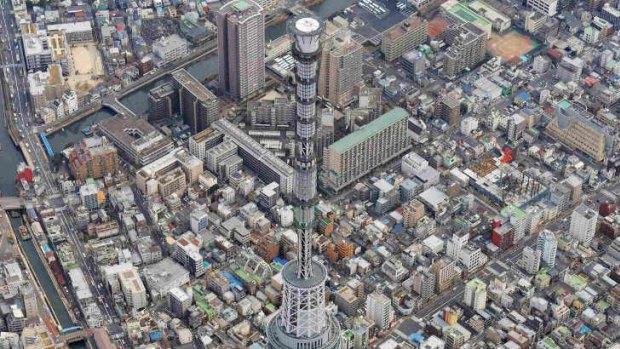
The tower hosts two observation decks -- at 350 metres and 450 metres above ground -- as well as restaurants and office space and sits at a former freight shunting yard along the Sumida river.Credit: Reuters
The operator of Tokyo Sky Tree on Tuesday explained how the world's second-highest building, and world's tallest communications tower, will survive the strong earthquakes that regularly shake Japan when it opens to the public next month.
"The Tokyo Sky Tree was constructed with state-of-the-art Japanese technology. It will not fall," said Yoshihito Imamura, deputy manager of Tokyo Sky Tree Town.
On Tuesday, the 634-metre tower, topped by a communications mast, was opened for the first time to media, attracting around 1,000 domestic and foreign journalists.
When the tower opens to the general public on May 22, the main attraction will be the two observation decks at 350 metres and 450 metres above ground.
"Once you go up here, you will see the entire Tokyo region," Imamura said. "You will see the curvature of the earth."
Journalists were taken inside the central pillar, where more than 2500 steps connect the top of the tower to the ground.
"When an earthquake hits, the central concrete pillar and the outer structure of steel pipes sway in opposite directions because of the difference in weights," said spokesman Sho Toyoshima.
"That means they can offset up to 50 per cent of the energy that will hit the tower."
Since the monster quake of March last year, the Tokyo area has been rocked by an average of around 1.5 quakes every day, and many in the densely populated capital fear it is long overdue for a devastating tremor.
The University of Tokyo's Earthquake Research Institute earlier this year said the city, built at the intersection of four tectonic plates, has a 50 percent chance of suffering a major quake -- anything above a magnitude 7.0 -- in the next four years.
Tourist bosses in the country hope the Tokyo Sky Tree will prove a draw for foreign visitors, whose numbers plummeted in the aftermath of the quake and tsunami disaster last year and the nuclear crisis it sparked.
The Tokyo Sky Tree tops the 600-metre Canton Tower in China's Guangzhou and the 553-metre CN Tower in downtown Toronto.
It is the world's second-tallest manmade structure, beaten only by the 828-metre Burj Khalifa in Dubai.
The Tokyo Sky Tree overshadows landmarks in the capital's upscale western parts, including the 333-metre Tokyo Tower, which was built in 1958 and became a byword in Japan for the country's rapid post-war growth.
AFP
Sign up for the Traveller Deals newsletter
Get exclusive travel deals delivered straight to your inbox. Sign up now.